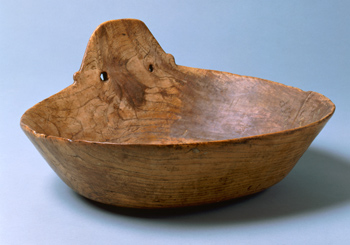Collections Online
Bowl attributed to the Wampanoag
To order an image, navigate to the full
display and click "request this image"
on the blue toolbar.
-
Choose an alternate description of this item written for these projects:
- MHS 225th Anniversary
- Main description
[ This description is from the project: Witness to America's Past ]
Traditionally known as "King Philip's Samp Bowl," this carved elm burl is a fine example of Algonquian craftmanship. Samp, or nasaump, the Algonquian term for the porridge made from ground Indian corn, was served in such bowls which were generally carved from hardwood knots or burls using crude flints, scrapers, and stone adze blades. Seven Algonquian bowls are known to exist, all monumental in size with ornamental handles depicting animal heads. (FN 1) This bowl was one of the earliest gifts to the Society and has been an important object in the Society's collections for more than 200 years. (FN 2) In 1803 Isaac Lothrop, one of the first members of the Society and register of probate for Plymouth County, (FN 3) purchased the bowl from Eleazer Richard for eight dollars. Less than a year later, Lothrop gave the bowl to the Society at which time members voted to have the bowl inscribed. (FN 4) The inscription, lettered in gold, inaccurately notes that one Richard killed King Philip. Lothrop's receipt from Eleazer Richard simply claimed that the samp bowl "was a portion of the trophy assigned to Eleazer Richard great-grandfather of the subscriber who made one of the party that terminated the existence" of King Philip. (FN 5) His identity is uncertain, but he may have been one Eleazer Rickard of Plympton, Massachusetts.
Metacomet, or King Philip as he was more popularly known among colonists, was the second son of Massasoit, sachem of the Wampanoag tribe of southeastern Massachusetts and one of the New England Native Americans who established peaceful relations with the Mayflower pilgrims. In 1662 King Philip succeeded his brother, Wamsutta, as Wampanoag chief and tried to preserve the peaceful coexistence between Indians and Englishmen, which his father had established forty years earlier. But the colonists' growing need for land strained these relations. Gradually, the accord between the Native Americans and colonists disintegrated, as King Philip united the fractious New England tribes against the expanding population of colonists. With the outbreak of war in June 1675, Philip's plans for a Native American nation to rival the English one seemed possible.
King Philip's united nation, however, was short-lived. Tribal disputes divided the people, eroding what power they had mustered. Inevitably, the Native Americans were no match for the well-armed colonists. In August 1676 a volunteer company under the command of Captain Benjamin Church ambushed King Philip's encampment in the marshes near Mount Hope. During this skirmish Philip was fatally shot by a Native American volunteer. (FN 6) Although King Philip's War lasted little more than a year (1675-1676), it resulted in the destruction of many colonial towns and the almost complete extermination of Native Americans in New England. Many who survived either fled to tribes in the West or were transported as slaves to the West Indies. (FN 7)
King Philip's samp bowl took a place of pride at the Society not only as a rare Native American artifact with a unique history, but also as a ceremonial object. Throughout much of the nineteenth century, the bowl was used for balloting with corn and beans at Society meetings. (FN 8) It appears in the center of the 1855 photograph of members.
Other objects relating to King Philip's War collected in the early years of the Society include Captain Benjamin Church's sword, worn the day Philip was killed, and a flintlock from the rifle reputedly used to kill Philip. Manuscript collections, notably the John Davis Papers, contain a number of accounts of King Philip's War and discussions of Native American relations during that period.
1. Willoughby, Charles C. Antiquities of the New England Indians. Cambridge, Mass.: The Peabody Museum of American Archaeology and Ethnology, Harvard University, 1935, pp. 260—262.
2. Proceedings of the Massachusetts Historical Society, 1st ser., 1(1791—1835): 163, 168, 7(1863—1864) :177.
3. Proceedings of the Massachusetts Historical Society, 2nd ser., 3(1886—1887): 384; Collections of the Massachusetts Historical Society, 2nd ser., 1(1814) :258—260.
4. Proceedings of the Massachusetts Historical Society , 1st ser., 1(1791—1835): 163.
5. Ibid., 163n.
6. Church, Benjamin. Diary of King Philip's War, 1675-76. Chester, Conn.: Published for the Little Compton Historical Society by Pequot Press, 1975, p. 153.
7. Hodge, Frederick Webb. ed. Handbook of American Indians North of Mexico. 2 parts. Washington: Govt. print. off., 1907, pp. 690—691; Leach 1958, pp. 236—237.
8. Proceedings of the Massachusetts Historical Society , 1st ser., 1(1791—1835): 163n.

